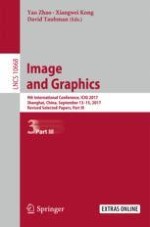2017 | Book
Image and Graphics
9th International Conference, ICIG 2017, Shanghai, China, September 13-15, 2017, Revised Selected Papers, Part III
Editors: Yao Zhao, Xiangwei Kong, David Taubman
Publisher: Springer International Publishing
Book Series : Lecture Notes in Computer Science
